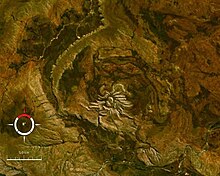Spider Crater

Coordinates: 16 ° 44 ′ S , 126 ° 5 ′ E
Spider is the name for an impact structure in the Kimberley region of Western Australia . Because of the very rough terrain, the heavily eroded impact crater is practically inaccessible . The name Spider (German "Spider") is derived from the conspicuous spider-like structure that can be seen in aerial and satellite images.
The unusual geological structure has been a mystery since the 1950s. It was only when cones of rays were found in the center in the late 1970s that it became clear that Spider was an eroded impact crater. The central area with the cones of rays is interpreted as the remnant of the central mountain. The outer boundaries of the fault are 11 to 13 km in diameter, assuming the original crater was larger. The asymmetry of the structure explain some geologists with the flat entry angle of the celestial body north or north-westerly direction, while other geologists see the cause in the original terrain.
The time of the impact has not been determined exactly, but it is believed that after the folding of the quartzite in the Proterozoic , but most local ice age took place erosion. If these assumptions are correct, then the impact would have occurred 600 to 900 million years ago.
swell
- Impact structures of the world Database by Jarmo Molianen.Retrieved October 26, 2010
- Earth Impact Database. Retrieved October 7, 2013
- A. Abels informaworld.com Spider impact structure, Kimberley Plateau, Western Australia: interpretations of formation mechanism and age based on integrated map-scale data.Retrieved October 26, 2010
- Shoemaker, EM & Shoemaker, CS SAO / NASA Astrophysics Data System (ADS) Proterozoic Impact Record of Australia. Retrieved October 26, 2010
